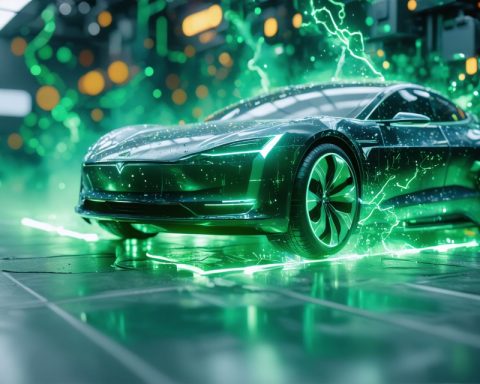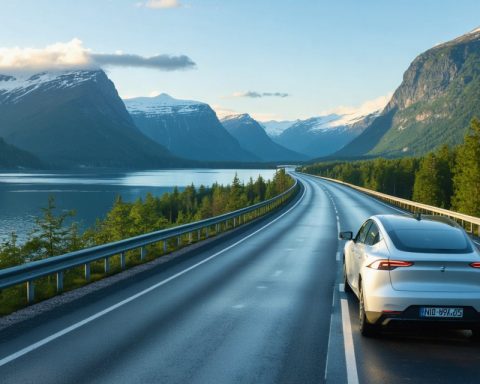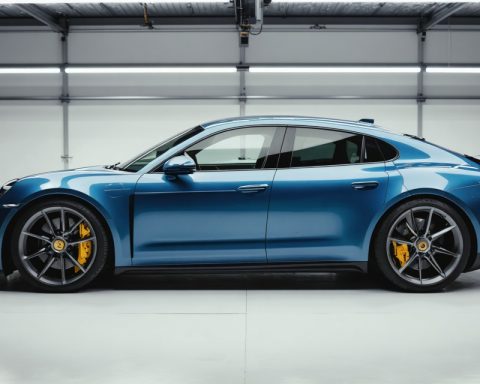- Electric vehicles (EVs) significantly reduce noise pollution, transforming urban soundscapes into quieter environments.
- EVs offer remarkable energy efficiency, converting up to 77% of stored energy into motion compared to 20% for traditional vehicles.
- By emitting no local pollutants, EVs improve air quality and enhance public health while reducing healthcare costs.
- The transition to EVs supports energy independence by reducing reliance on fossil fuels and integrating renewable energy sources.
- Advancements in battery technology and manufacturing have made EVs increasingly accessible, expanding their global reach.
- Many cities aim to achieve carbon neutrality with EV adoption as a central strategy, transforming urban infrastructure for sustainability.
Electric vehicles (EVs) glide silently through our cities, shaping a future that balances sleek technology with environmental responsibility. These modern marvels are not just cars; they are sculptors of tomorrow’s urban spaces, redefining the rhythm and soundscapes of bustling streets.
Imagine walking through the heart of a metropolis. The usual cacophony of gas-powered engines is replaced by the near-silent whisper of electric motors. This serenity reveals a profound truth: EVs play an integral role in reducing noise pollution, providing city dwellers with a more peaceful environment. Just as photosynthesis quietly sustains life, EVs quietly improve urban quality of life without fanfare.
Remarkable Efficiency
Unlike their internal combustion counterparts, which convert only about 20% of the energy stored in gasoline into motion, EVs can boast an energy conversion efficiency of up to 77%. This staggering improvement translates into fewer energy demands, making EVs not only greener but also more economically viable over time.
Improving Air Quality
Electric vehicles do more than silence the streets; they cleanse the air. Traditional vehicles spew out carbon monoxide, nitrogen oxides, and particulates, harmful pollutants which EVs do not emit locally. As cities embrace EVs, air quality improves, directly benefiting public health by reducing respiratory ailments and healthcare costs.
Energy Independence
Urban landscapes are becoming less reliant on fossil fuels, pivoting towards renewable energies like solar and wind, often stored for later use by EVs. This transition not only mitigates the volatility of fuel markets but also strengthens urban resilience against energy shocks.
Leading by Innovation
Once bound by hefty price tags, the proliferation of EVs is now fueled by advancements in battery technology and manufacturing processes, making them increasingly accessible. Long regarded as a luxury, EVs are democratizing across the globe, driven by both consumer demand and strategic policy incentives.
The Future Unfolds
Many cities are setting ambitious targets to become entirely carbon neutral within the coming decades, with EV adoption being a cornerstone of their strategy. Charging stations replace gas pumps, parking lots transform into green parks with charging amenities, and smart grids manage energy flows in real-time, creating an interconnected ecosystem that thrives on sustainability.
Conclusion
As EVs take center stage, a quiet revolution is underway, crafting urban experiences that prioritize sustainability and serenity. The steady hum of electric motors signals progress, urging us all to participate in shaping an electrified future. Embracing EVs today means investing in a world where urban landscapes become cleaner and quieter for generations to come.
Takeaway: Electric vehicles are not just about technology; they are catalysts for creating smarter, cleaner, and more peaceful cities. Their impact on noise reduction, air quality, and energy efficiency nurtures a hopeful vision of the urban future—one where quiet and clean spaces become the norm rather than the exception.
Why Electric Vehicles Are Essential For Future Cities: A Deep Dive Into EV Impact
Electric vehicles (EVs) are drastically altering the landscape of urban environments with their advanced technology and emphasis on sustainability. While the core benefits of EVs, such as noise reduction and improved air quality, have been well-documented, there are numerous additional aspects to consider when understanding the full impact of EVs on the future of cities.
How EVs Revolutionize Transportation
1. Infrastructure Development: The rise of EVs necessitates new infrastructure, including widespread charging stations. Cities are integrating these stations in strategic locations to ensure accessibility. This infrastructure revolution is also a stepping stone toward intelligent transportation systems.
2. Battery Technology and Range: Advances in battery technology continue to reduce charging times and increase travel ranges. Lithium-ion batteries are the norm, but solid-state batteries are on the horizon, promising even greater efficiencies and safety (Deloitte, 2021).
3. Cost of Ownership: Initial EV costs can be higher than traditional vehicles, but the total cost of ownership is often lower. EVs typically require less maintenance, and energy costs are generally lower than gasoline prices (Consumer Reports, 2020).
Market Forecasts & Industry Trends
1. Market Growth: The global electric vehicle market is projected to grow significantly in the coming decades, driven by policy incentives, improvements in technology, and the push for carbon neutrality. The International Energy Agency (IEA) predicts that by 2030, EVs could make up 30% of all vehicle sales.
2. Government Policies: Numerous governments are offering incentives and tax breaks to encourage EV adoption. For instance, countries like Norway lead the charge, aiming to phase out new internal combustion engine vehicles by 2025.
3. Automaker Commitment: Major automobile manufacturers are pledging to transition entire fleets to electric by as early as 2035, with companies such as General Motors spearheading these efforts.
Real-World Use Cases and Innovations
1. Fleet Electrification: Urban areas are increasingly electrifying public transport and delivery fleets, improving air quality and reducing city noise.
2. Vehicle-to-Grid Technology (V2G): EVs potentially act as decentralized energy storage units, feeding electricity back to the grid during peak demand periods. This creates more resilient and balanced energy systems.
3. Shared Mobility Services: EVs are ideal for car-sharing services, reducing the number of vehicles needed in urban areas and minimizing individual carbon footprints.
Security & Sustainability Insights
1. Data and Security: EVs collect large amounts of data, raising privacy concerns. Manufacturers and governments are working to ensure robust cybersecurity measures are in place.
2. Environmental Impact: While EVs produce zero emissions during operation, battery production can be resource-intensive, necessitating sustainable mining practices and recycling programs (Union of Concerned Scientists, 2018).
Challenges and Controversies
1. Charging Infrastructure: Many regions still lack adequate charging stations, which can deter potential EV owners. Collaborations between governments and private sectors are needed to address this gap.
2. Resource Dependence: EV batteries require materials such as lithium, cobalt, and nickel, whose mining can be environmentally and ethically challenging.
3. Grid Capacity: As EV adoption grows, so does electricity demand. Utilities must upgrade infrastructure to prevent overload scenarios.
Actionable Recommendations
– Consider an EV Switch: Evaluate your travel needs, review incentives, and consider transitioning to an EV for cleaner, quieter commutes.
– Support Local Policies: Advocate for policies that promote charging infrastructure and sustainable practices.
– Stay Informed: Follow technological advancements and manufacturer announcements to make informed decisions on future vehicle purchases.
For those curious about further innovation in electric transportation, check out comprehensive insights at credible automotive news sites and technological publications.
EVs are more than just futuristic gadgets; they are critical players in shaping cities where green practices take precedence. In choosing electric, we not only contribute to environmental goals but embrace a lifestyle aligned with a cleaner, quieter urban future.












